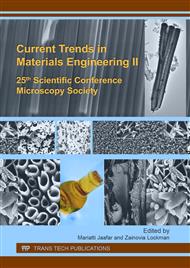p.54
p.58
p.62
p.66
p.70
p.74
p.79
p.83
p.87
Fabrication of PEDOT:PSS/Graphene Conductive Ink Printed on Flexible Substrate
Abstract:
Nowadays, flexible electronic is an important technology to produce flexible electronic devices due to it offers the attractive features such as possibility of product types and designs, with reducing size and weight, and low cost. Poly (3,4-ethelenedioxythiophene):poly (stylenesulfonate) (PEDOT:PSS) is a conductive polymer which possess high conductivity, high electrochemical, and low redox potential. PEDOT:PSS and PEDOT:PSS/Graphene (GP)/Dimethyl sulfoxide (DMSO) conductive ink ware deposited on Polyethylene terephthalate (PET) flexible substrate using desktop inkjet printer. Conductivity and thickness of conductive pattern at 1, 3, 5, 10, 20 layers were investigated in this study. It is observed that sheet resistivity of the conductive pattern is influenced by number of printed layers. Addition of GP at 20 layers of PEDOT:PSS/GP/DMSO conductive pattern exhibits the lowest sheet resistivity at 44 ohm/󠇯󠇯sq compared to PEDOT:PSS conductive pattern of 1.81×104 ohm/󠇯󠇯sq.
Info:
Periodical:
Pages:
70-73
Citation:
Online since:
September 2017
Keywords:
Price:
Сopyright:
© 2017 Trans Tech Publications Ltd. All Rights Reserved
Share:
Citation:


